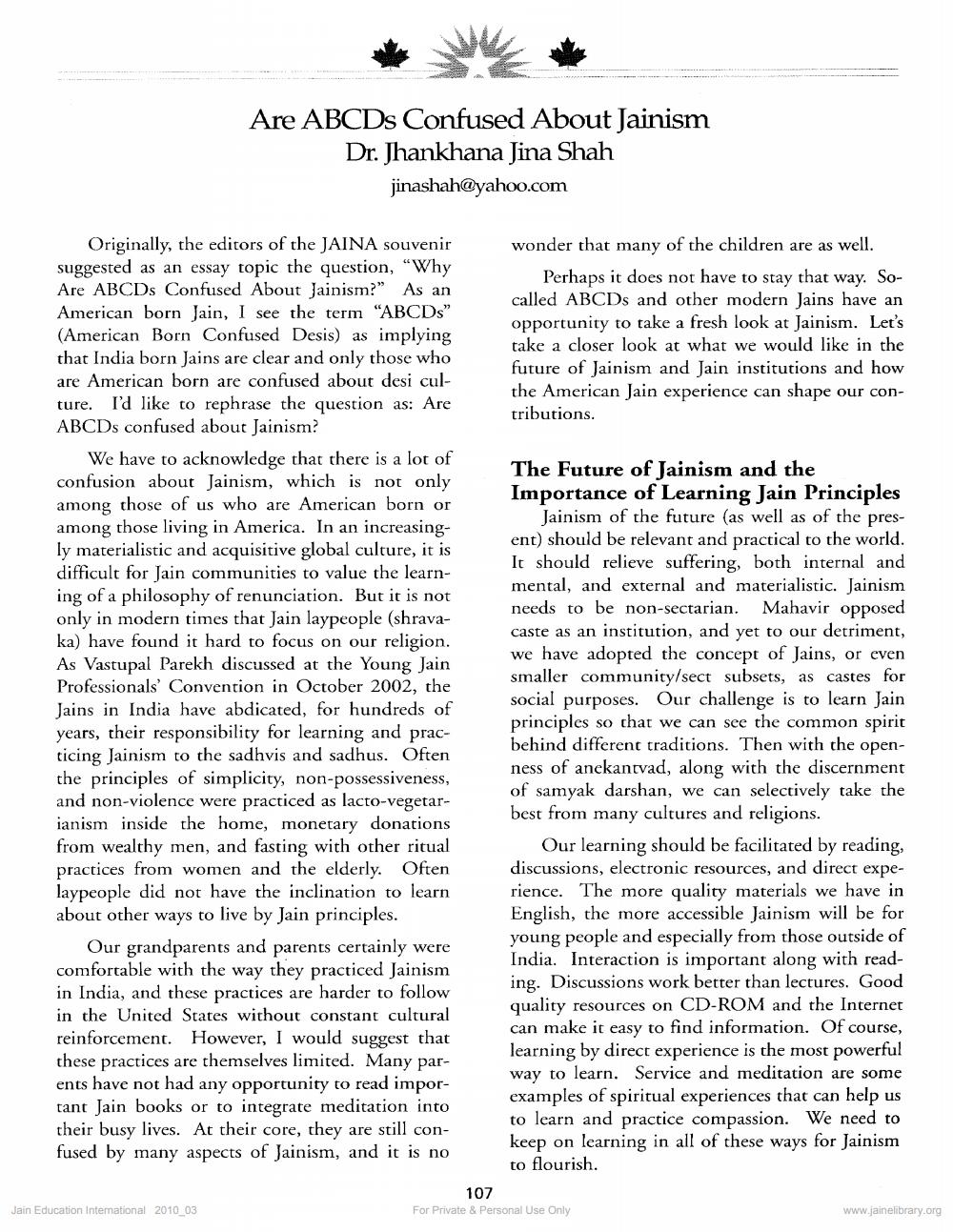________________
Are ABCDs Confused About Jainism Dr. Jhankhana Jina Shah
[email protected]
Originally, the editors of the JAINA souvenir suggested as an essay topic the question, "Why Are ABCDs Confused About Jainism?" As an American born Jain, I see the term "ABCDs" (American Born Confused Desis) as implying that India born Jains are clear and only those who are American born are confused about desi culture. I'd like to rephrase the question as: Are ABCDs confused about Jainism?
We have to acknowledge that there is a lot of confusion about Jainism, which is not only among those of us who are American born or among those living in America. In an increasingly materialistic and acquisitive global culture, it is difficult for Jain communities to value the learning of a philosophy of renunciation. But it is not only in modern times that Jain laypeople (shravaka) have found it hard to focus on our religion. As Vastupal Parekh discussed at the Young Jain Professionals' Convention in October 2002, the Jains in India have abdicated, for hundreds of years, their responsibility for learning and prac ticing Jainism to the sadhvis and sadhus. Often the principles of simplicity, non-possessiveness. and non-violence were practiced as lacto-vegetarianism inside the home, monetary donations from wealthy men, and fasting with other ritual practices from women and the elderly. Often laypeople did not have the inclination to learn about other ways to live by Jain principles.
Our grandparents and parents certainly were comfortable with the way they practiced Jainism in India, and these practices are harder to follow in the United States without constant cultural reinforcement. However, I would suggest that these practices are themselves limited. Many parents have not had any opportunity to read important Jain books or to integrate meditation into their busy lives. At their core, they are still confused by many aspects of Jainism, and it is no
Jain Education International 2010_03
wonder that many of the children are as well.
Perhaps it does not have to stay that way. Socalled ABCDs and other modern Jains have an opportunity to take a fresh look at Jainism. Let's take a closer look at what we would like in the future of Jainism and Jain institutions and how the American Jain experience can shape our contributions.
The Future of Jainism and the Importance of Learning Jain Principles
Jainism of the future (as well as of the present) should be relevant and practical to the world. It should relieve suffering, both internal and mental, and external and materialistic. Jainism needs to be non-sectarian. Mahavir opposed caste as an institution, and yet to our detriment, we have adopted the concept of Jains, or even smaller community/sect subsets, as castes for social purposes. Our challenge is to learn Jain. principles so that we can see the common spirit behind different traditions. Then with the openness of anckantvad, along with the discernment of samyak darshan, we can selectively take the best from many cultures and religions.
Our learning should be facilitated by reading, discussions, electronic resources, and direct experience. The more quality materials we have in English, the more accessible Jainism will be for young people and especially from those outside of India. Interaction is important along with reading. Discussions work better than lectures. Good quality resources on CD-ROM and the Internet can make it easy to find information. Of course, learning by direct experience is the most powerful way to learn. Service and meditation are some examples of spiritual experiences that can help us to learn and practice compassion. We need to keep on learning in all of these ways for Jainism to flourish.
107
For Private & Personal Use Only
www.jainelibrary.org




